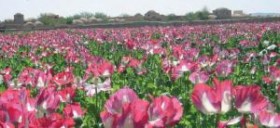Illicit opium poppy production cultivation in Afghanistan is on the increase this year, the Afghan Ministry of Counternarcotics said Monday. The increase comes despite efforts to target traffickers and to provide alternate development opportunities for farmers.
Opium is the raw material from which heroin and other narcotics are derived.
Opium production has been a mainstay of the economy in the war-ravaged country ever since the US and NATO forces invaded in October 2001. Prior to the invasion, the Taliban had allowed poppy growing up until 2000, when a ban dramatically lowered production. But production took off again after the invasion, and for the past decade, Afghanistan has accounted for the vast bulk of global opium production, producing as much as 90% of the total supply.
Efforts to suppress opium production have been half-hearted and ineffective, in part because doing so threatens to drive poppy-producing peasants into the hands of the Taliban and in part because Afghan officials are themselves implicated in the trade.
Qayum Samir, a ministry spokesman, told Radio Free Europe Monday that 157,000 hectares are being planted with poppies this spring. That’s up by an estimated 3,000 hectares over last year. Samir said the rise in production could be blamed on lack of security (read: lack of effective government control) and widespread poverty.
He said the Karzai government and the ministry have set up special task forces to eradicate opium plantings in four southern and southeastern provinces — Farah, Helmand, Kandahar, and Nimruz. Those provinces are also areas where the Taliban is strong. Samir said task forces in other parts of the country would come later.
Article republished from Stop the Drug War under Creative Commons Licensing










